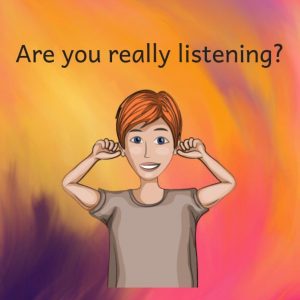How often do you find yourself walking away from a conversation not remembering what was just discussed. Or having your partner or child tell you they told you’re something but you can’t remember what they’ve said? 
Stress impacts us from all avenues of our life. And as stress increases, so does the inability for us to really hear what is being said. Being an active listener is vital when communicating with others and is important, but stress impedes the auditory processing systems in our brains. When we are under stress we may begin to favour listening more with one ear rather than from two integrated ears.
When we are in this state we tend to either listen to the words, without listening to the tone or metaphor or we listen to the emotion of what is being said and miss the crucial details. This becomes more of an issue if our default ear is the same side as our dominant hemisphere.
If our default favours the left ear we will tend to hear more of the melody or tone of what is being said, as well as the emotion, but we may miss the actual details.
If our default favours the right ear we will hear the details of what is being said but may miss the tone. As any competent listener knows, the tone or emotion behind what is being said is just as important as they details.
To determine your dominance, without giving it much thought, walk towards a door and press your head against it as if you were going to listen through the door. That is your dominant or preferred ear.
Integrating our auditory processing system is not that difficult.
Firstly Breathe
When we are under stress our breathing becomes shallow. We may hold our breath or not breathe deeply enough. Do you notice yourself randomly taking a deep breath when you are stressed? Or even yawning more often? This is the body’s natural way of increasing oxygen into the body and brain.
If this seems to be occurring more and more then it’s time to make time periodically to tune into your breathing. Start by noticing how you are breathing. Next start taking in a deep breathe in through the nose and then breathe slowly out through your mouth. Spend about 5 minutes just breathing.
Massage your ears
Our ears have numerous pressure points which are connected to many of our neck muscles. Stress, poor posture or just sleeping on the wrong angle can often leave us with tightness in our neck. The pressure points in our ears help to release the tension in our neck muscles giving us more movement as well as activating the auditory processing pathways in our brain.
Before you go on, turn your head from side to side (as if you were saying no) noticing if one side feels tighter than the other.
Now, use your thumbs and index fingers to pull your ears gently back and unroll them. Begin at the top of the ear and massage down and around the curve, ending with the bottom lobe. Repeat three or more times. You can check out the video here on YouTube https://youtu.be/mMyChtRxPLw.
Once you have finished, turn your head from side to side again and notice the difference. It may feel like you have just lubricated your neck muscles!
So there are my two tips on helping you integrate you hearing so that you don’t miss anything important. Give these a go and watching your hearing improve!
And remember, Happiness Starts with a Smile and Empowerment Starts with a Choice!


